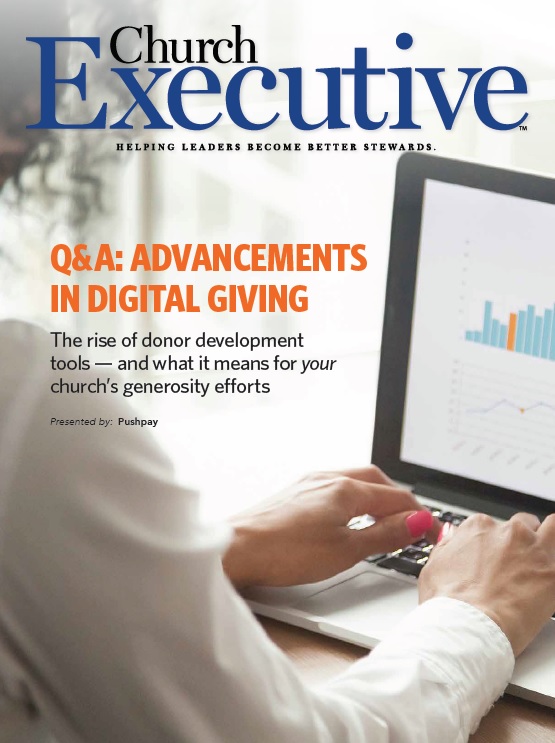
The rise of donor development tools
It seems that donor development tools have become a focus related to digital giving. First, what is meant by “donor development”?
Troy Pollock: Donor development, or donor management, has been around for a while, especially within the non-profit sector. However, this is a fairly new methodology in the church. The thought around creating a donor development strategy is really to enable your team to have visibility into the activity within their congregation — specifically regarding giving — to take action and reach people in more personal and meaningful ways. A donor development strategy helps leaders in the church focus on ways to nurture donors and creates a cycle of generosity both from the church and its congregation. The goal is ultimately to reach people and understand where they are in their faith journey. And more importantly, how to help move them forward when ready. Because we know that when you invest in individuals — recognize them, thank them, and nurture them — they are more likely to give in return, whether that’s financially, with their time, or other means.

Chief Ambassador
Pushpay
Why is it important to integrate donor development tools with digital giving?
Pollock: At Pushpay, we are fortunate enough to partner with more than 8,000 churches. Across the board, we’ve seen giving behavior from these churches follow a similar trend. We call it the 80/20 rule. In other words, about 80% of your total annual giving comes from about 20% of your congregation. Because of this, each contributor is vitally important to the sustainability of the church. These financial contributors are supplying the resources to fuel the mission of the church — inside and outside the four walls. Donor development is undeniably important, and can be directly facilitated with the digital giving tools and resources we’ve built at Pushpay.
Digital giving platforms now appear to offer more insights into givers’ engagement in their churches. What are some specific insights church leaders are able to look for, and identify, that could be beneficial?
Pollock: One of the things churches are now able to view with a click of a button is a quick report of first-time donors, recurring donors, at-risk donors, lapsed donors and more. Church staff can view the lists, or drill down to individuals, and take the appropriate action. Depending on where people are in their donor journey, that could mean sending a thank you note, following up with a phone call, inviting them to a small group, or more. Really the idea is about being able to reach and connect with people in meaningful ways.

In fact, financial contribution is oftentimes the last act of participation a person will make at a church. They might view online, attend in-person, get baptized or serve on a team all before they financially contribute.
Conversely, giving financially is usually the first thing to stop when people face challenges of many kinds. Data provides visibility into those changes in behavior and can surface when a person might be going through a season of transition. The opportunity is being able to take action on that data and move someone along their financial stewardship or help identify people that might need pastoral care.
Are there digital giving apps or technology developments that church leaders should be aware of?
Pollock: We’ve launched several new features within the Pushpay app and giving solutions recently, but the two that I’m personally most excited about are:
Donor pledging: Annual pledges and giving campaigns are an important part of a stewardship strategy for many churches, but can be incredibly time-consuming to manage manually. New donor pledge entry capabilities allows community members to commit to and enter a pledge directly from their mobile device! Donors can also track their progress towards their pledge, which is a huge time saver for both the church and users.
Self-access giving statements: Church administrators have the ability to publish their donors’ giving statements directly onto individual profiles, giving donors access to view and download their statements from their account. This saves church administration teams countless hours each year.
In addition, all our donor development tools can be accessed via mobile, which is a huge win for church staff to be able to view those insights on the go.
We know digital giving makes it easier and more immediate to give. But how does it make life easier on the administrative end?
Pollock: We know that digital giving saves church administration teams countless hours every year. But it’s not just the ease of use for end users. Time savings are really maximized when you’re able to integrate all of your tools into one source so church finance teams have an accurate account of every dollar coming into the church. Whether that’s check scanning, text to give, giving from a kiosk, tracking charitable donations, or more. A full-circle digital giving solution streamlines those channels into a single source which is a life-changer for administrative teams.
If a church has been using the same digital giving platform for a while and is hesitant to switch, what does that transition process look like?
Pollock: We know that change is hard. Yet, in today’s ever-changing technology environment, it’s a good practice to stay up to date with the latest solutions and innovations within church tech. Whether you’re growing, in transition, or are looking for new ways to engage your congregation — there is a great solution out there for you that will fit the needs of your church.
It’s important to ask the right questions to enable a seamless onboarding experience. Will historical data be imported? How will congregants be notified of the change? Do you have a template communication to work from? How do we help mitigate the loss of recurring givers? These are all important questions that a care team should be able to answer for you to ensure a smooth transition.
— Reporting by RaeAnn Slaybaugh


